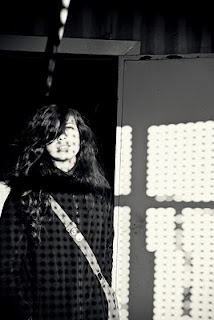Gather round, my little ones, for a tale of
TERROR!
Doctor Becca was a post-doc, just like any other. She had a lab. She had a PI. She had data. She had a
blog. She had
tweeps she could count on.
But she was always filled with a sense of foreboding... that suspicions that one day, that it could all go horribly, terribly wrong.
On the day that
it happened, she said, in the sad tone of one who had foreseen her fate:
I knew this day was but a mere eventuality.
Because she was hard-working and industrious, she had a chance to go, one warm summer day not too long ago, to a conference. The conference was a long way , so she had to prepare for the trip. She would have to fly... fly away from the safety of her lab and her home.
She prepared her poster, like a good post-doc should. She showed it to her colleagues in the lab. It was, they all said, a thing of beauty. Surely someone would come see it at the conference and offer her the tenure-track position she so desired on the spot, so elegant were the experimental designs, so convincing were her data.
She boarded the plane that day. The skies were blue up above the clouds, she almost forgot her low sense of impending dread.
t was only after she stepped off the plane, in the busy, confusing surrounding of the airport, that she discovered the
awful truth!
Have arrived at the airport; my poster has not.
And let
this be a warning to you, my friends! Take heed! Or the terrible fate that befell our poor Doctor Becca could happen... to
YOU!
True story.
Luckily for Doctor Becca and other conference goers, this is far less of a disaster than it used to be. It used to be that if your poster didn’t arrive, you were completely shut out.
As Biochem Belle
noted, you can take the electronic file on a flash drive, as most locations that can run scientific conferences are likely to have printers of some sort nearby. Of course, many people are moving to cloud computing, which allows you to get to your files on
Google Docs or
Dropbox anywhere you can find a live internet connection. If there isn’t a local business printer that can handle large documents, there are
printing companies online that will print large format posters and ship it it by courier overnight.
To prepare for these kinds of situations, it helps to have your file in a format that most people can work with. The original “native” files generated by your graphics software can have problems when you move to another machine. Many specialty fonts that you might use don’t transfer from one computer to the next.
And then there’s a whole new strange set of horizons you see when you try to move something from a Mac to Windows and back again...
Probably the simplest format to save in in case of emergency is PDF format, which is “what you see is what you get” and is widely accepted. Some printers like to work with EPS files, and that makes a good second emergency back-up format (although there are a few finicky choices in the save options that might slow you down).
As for Doctor Becca? She was able to get a friend to
ship the completed poster via courier. She commented later that it was
cheaper to have the existing poster shipped than to reprint it.












